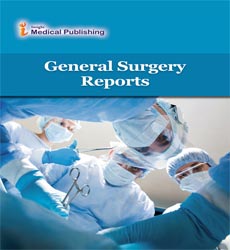Advancements and Applications of Retinal Surgery: Preserving Vision through Precision and Innovation
Bernardo Diego*
Department of Surgery, University of Medicine, New Haven, USA
- *Corresponding Author:
- Bernardo Diego
Department of Surgery, University of Medicine, New Haven,
USA,
E-mail: diego@gmail.com
Received date: May 14, 2024, Manuscript No. IPGSR-24-19069; Editor assigned date: May 16, 2024, PreQC No. IPGSR-24-19069 (PQ); Reviewed date: May 30, 2024, QC No. IPGSR-24-19069; Revised date: June 06, 2024, Manuscript No. IPGSR-24-19069 (R); Published date: June 13, 2024, DOI: 10.36648/2393-8854.11.2.164
Citation: Diego B (2024) Advancements and Applications of Retinal Surgery: Preserving Vision through Precision and Innovation. Gen Surg Rep 11.2:164.
Description
Retinal surgery is a specialized field within ophthalmology focused on treating various conditions affecting the retina, the thin layer of tissue lining the back of the eye that is responsible for capturing light and sending visual signals to the brain. These conditions can range from retinal detachment and macular holes to diabetic retinopathy and Age-Related Macular Degeneration (AMD). Retinal surgery aims to restore or preserve vision by repairing abnormalities or damage to the retina and surrounding structures. One of the most common reasons for retinal surgery is retinal detachment, a serious condition in which the retina pulls away from its normal position along the back wall of the eye. Without prompt treatment, retinal detachment can lead to permanent vision loss. Retinal detachment surgery typically involves reattaching the retina to the underlying tissue, either by sealing retinal tears with laser or cryotherapy (freezing) or by using small gas bubbles or silicone bands (scleral buckling) to support the retina in place.
Retinal surgery
Another condition that may require retinal surgery is a macular hole, a small break or defect in the macula, the central part of the retina responsible for sharp, detailed vision. Macular hole surgery involves delicately removing the vitreous gel that fills the eye's center (vitrectomy) and peeling away the membrane causing the hole. This allows the retina to flatten and the hole to close, improving central vision. Diabetic retinopathy, a complication of diabetes that affects the blood vessels in the retina, may also necessitate retinal surgery in advanced cases where abnormal blood vessels bleed into the eye or cause swelling and scarring. Surgical interventions for diabetic retinopathy include vitrectomy to remove blood and scar tissue from the retina, as well as laser photocoagulation to seal leaking blood vessels and prevent further damage. Age-Related Macular Degeneration (AMD), a leading cause of vision loss in older adults, can sometimes require retinal surgery in its advanced "wet" form, characterized by abnormal blood vessel growth beneath the retina. Retinal surgery options for wet AMD include intravitreal injections of anti-vascular endothelial growth factor (anti-VEGF) medications to inhibit blood vessel growth and Photodynamic Therapy (PDT) to selectively destroy abnormal blood vessels using laser light. Additionally, retinal surgery may be indicated for other retinal conditions such as retinal vein occlusion, epiretinal membrane, and retinoschisis, among others. The specific surgical approach depends on the nature and severity of the condition, as well as the patient's overall health and visual needs.
Surgical skills
Advancements in retinal surgery techniques and technology have significantly improved surgical outcomes and expanded treatment options for patients. Microincisional Vitrectomy Surgery (MIVS) allows surgeons to perform minimally invasive procedures using smaller instruments and incisions, resulting in faster recovery times and reduced postoperative discomfort. Additionally, the introduction of intraocular dyes, enolase probes, and wide-angle viewing systems has enhanced surgical visualization and precision, leading to better anatomical and functional outcomes. Despite these advancements, retinal surgery remains a complex and delicate procedure that requires specialized training and expertise. Retinal surgeons undergo extensive training in ophthalmology and additional fellowship training specifically focused on diseases of the retina and vitreous. They must possess advanced surgical skills, meticulous attention to detail, and a deep understanding of retinal anatomy and pathology to achieve optimal outcomes for their patients. In conclusion, retinal surgery plays a important role in the management of various retinal conditions, offering hope for preserving or restoring vision in patients with sightthreatening diseases. From repairing retinal detachments and macular holes to treating diabetic retinopathy and AMD, retinal surgeons employ a range of surgical techniques and technologies to address the diverse needs of their patients. With ongoing advancements in surgical techniques and instrumentation, the future of retinal surgery holds promise for further improving outcomes and expanding treatment options for individuals with retinal diseases.
Open Access Journals
- Aquaculture & Veterinary Science
- Chemistry & Chemical Sciences
- Clinical Sciences
- Engineering
- General Science
- Genetics & Molecular Biology
- Health Care & Nursing
- Immunology & Microbiology
- Materials Science
- Mathematics & Physics
- Medical Sciences
- Neurology & Psychiatry
- Oncology & Cancer Science
- Pharmaceutical Sciences
